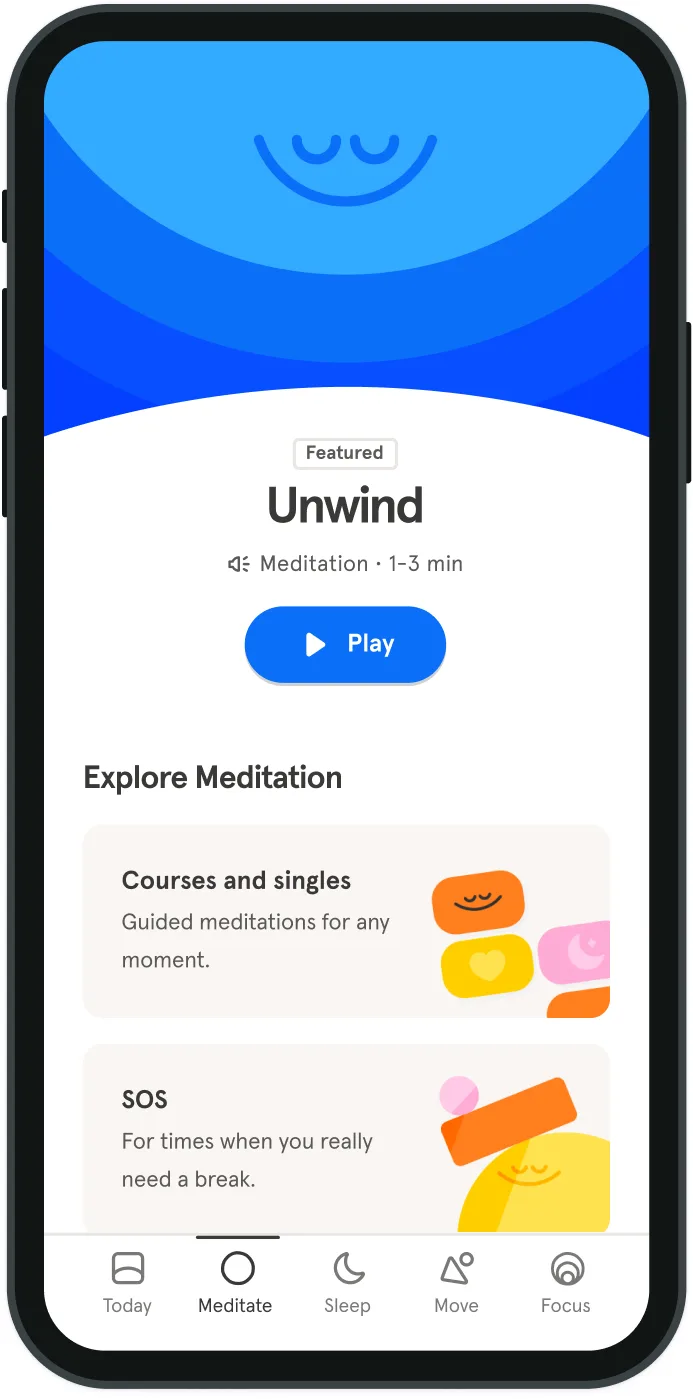Stress fatigue might be why we feel exhausted
Even in the calmest waters, navigating life can be stressful. But when the storm is unrelenting, like during the extraordinarily difficult year 2020, the build-up of stress can take a toll on our well-being. According to the American Psychological Association’s 2020 Stress in America survey, 2 out of 3 adults faced increased stress during the COVID-19 pandemic. The survey also stated that the “issues they are stressed about are not going away, they are piling up.”
When faced with persistent challenges — including ones that show no sign of letting up — the overload of stress can make it much more difficult to cope. Life can feel too much. Circumstances can feel beyond our control. And the pressure, internally and externally, keeps mounting. At this point, we might feel an overwhelming sense of exhaustion, burnout, or numbness from the accumulated stress called stress fatigue (or crisis fatigue).
But what can be done when we’re “running on empty”? We might start by acknowledging that we can’t always control the events in the world around us, but we can control and change the way we respond to them. By practicing mindfulness, we can train the mind to be calmer, less reactive, and ultimately better equipped to manage stress in times of crisis.


Watch: Meditation to Reframe Stress - 10 min
10mins
Key takeaways:
We can feel stress exhaustion in all areas of our lives when stress compounds
Similar to how prolonged stress can rewire the brain to react in a certain way, a regular meditation practice can train the mind to feel more relaxed
Try 18 meditations to ease stress fatigue
What is stress fatigue?
Stress fatigue has been studied for quite some time, but became a hot topic again in 2020. During a recent examination of stress fatigue, researchers returned to the work of Diane Meyers and Leonard Zunin, medical experts in trauma, who in 2000 developed a widely used conceptual framework of disaster response and recovery. According to this framework, communities confronted with a disaster typically experience 6 emotional phases:
Pre-disaster: The fear of the uncertain.
Impact: The shock of the crisis.
Heroic: Feelings of altruism as communities unite.
Honeymoon: Feeling of camaraderie and optimism things will return to normal.
Disillusionment: Feelings of discouragement and abandonment creep in.
Reconstruction: Feelings of recovery as people adjust to their new normal.
It’s during the disillusionment period that people typically experience stress fatigue, when the feeling of togetherness that initially arises to fight a crisis wanes, and people begin to feel mentally, physically, and emotionally drained by the situation they find themselves in.
While this research applies to dealing with disasters, we can feel stress exhaustion in all areas of our lives when stress compounds. If left to spiral over time, this can have a significant impact on our health and happiness.
How stress fatigue affects the mind and body
Stress stimulates the sympathetic nervous system and causes a surge of natural stress hormones — specifically epinephrine and cortisol — into the bloodstream. This flood of hormones causes many of the physical changes we associate with moments of stress, such as elevated heart rate, rapid breathing, increased blood pressure, tensed muscles, and quickening pulse.
This preparation is an ideal ‘fight or flight’ response in life-or-death situations. But when it’s constantly triggered by things that are concerning but not an immediate danger — for example, worry caused by endless bad news or content on social media — then it can become disruptive, causing negative physical and mental symptoms.
During a crisis that lasts for several months or even years, the body can eventually experience something called allostatic overload, which refers to the cumulative wear and tear on an individual’s body, mind, and emotions that occurs when dealing with stress for long periods of time. Through a process called neuroplasticity, stress can even reshape the structure and neural pathways of the brain to make stress the default mode.
But there are ways we can prevent this stress from becoming overwhelming or less so, even in prolonged times of crisis. Through the practice of mindfulness, we can learn to control our internal environment — our thoughts, the stories we tell ourselves, the emotions that arise, the overanalysis we indulge — to be best prepared to handle the stress and fatigue that are inevitable parts of life.
How to manage stress fatigue
Meditation is not about ridding ourselves of stress or ignoring it, but becoming more in tune with the feelings and emotions it causes to give us a fresh perspective to let them go. Instead of becoming entangled in our stress, we learn how to free ourselves and step away from it. We change our relationship with stress.
Headspace co-founder and former Buddhist monk Andy Puddicombe says, “We can keep telling ourselves 'I’m stressed, I’m stressed, I’m stressed' and thereby ensuring that’s the way we’d feel, or we can take a slightly different perspective and use our newfound awareness to become curious.
“If you take the time to get to know stress through the application of mindfulness, then it can start to look like an altogether different beast.”
In a similar way to how prolonged stress can rewire the brain to react in a certain way, a regular meditation practice can train the mind to feel more relaxed. One way to look at meditation is to view it as training to reprogram the brain — changing the way we react to stress in the short and long term.
The amygdala is our emotional thermostat in the brain and the stresses of modern-day life mean it tends to operate in a heightened state of alert, being triggered by small stressors and major stressors. We get stressed out easily because of the amygdala’s disproportionate ‘fight or flight’ response.
We can help to overcome this fight or flight response by instead triggering a relaxation response to slow the breathing rate, relax our muscles, and reduce blood pressure. We learn to do this during a meditation practice, then apply the same principles in everyday life when things feel too much. Meditation essentially trains the amygdala to better understand how much reaction we should be having. We are suddenly more skilled at maintaining emotional regulation on our own.
In fact, a 2018 study found that the participants who used Headspace for just 10 days had a 12% decrease in stress. And a separate study found that people who used Headspace for 30 days reduced stress by a third.
And alongside a meditation practice, there are science-backed ways we can combat prolonged stress in our lives.
Exercise stimulates the production of “feel good” endorphins, which help to increase euphoria and boost mood.
A good night’s sleep can help to improve emotional regulation and increase our ability to tolerate frustration.
Good nutrition can also help manage stress by stabilizing the level of sugar in the blood.
By focusing on things that bring us joy, and engaging in activities that help us escape from stress and tiredness; we’re reminded of the positives in life.
Limiting media exposure can also be a sensible step. Constantly seeking out bad news — aka doom scrolling — can also exacerbate the negative emotions we’re already experiencing. Try designating set times for news consumption and stick to them. We can be educated and informed without exposing ourselves to the 24/7 news cycle.
We can also try seeking out a happy friend. Moods are contagious — it’s true. Research shows that we’re 25 percent more likely to be happy when a nearby friend is upbeat.
Try 18 meditations for stress
Looking for meditations that help in managing stress? The Headspace app has a Reframe Stress and Relax collection that offers subscribers several courses and single meditations for immediate and long-term stress reduction, including:
Letting Go of Stress course. Learn to reframe negative emotions and let them go.
Restlessness course. Learn to work with a restless mind more skillfully.
Transforming Anger course. Connect with anger and use it to train your mind.
Navigating Change course. Train your mind to be more comfortable with change.
How We Forgive Ourselves guidance. Being present helps us leave regret in the past.
Feeling Overwhelmed meditation. Give yourself room to breathe.
Burned Out meditation. Step away from worried thoughts.
Panicking meditation. Anchor your mind and body in the present.
Losing Your Temper meditation. Let go of whatever’s causing you to feel frustrated.
Flustered meditation. Bring an unsettled mind back to the subject at hand.
In Pain meditation. Change your relationship with physical pain.
Stress Release workout. Step away from stress and into the moment.
Unwind meditation. Lead your mind to a natural place of rest.
Restore meditation. Let go of any tension or busyness in the mind.
Frustrated meditation. Let go of tension and find a little peace of mind.
Stressed meditation. Recognize what’s occupying your mind and let it go.
Taking a Break meditation. Press pause in the middle of your workday.
Reset meditation. Find some focus and relaxation during a busy day.
However we choose to unlock happiness in times of extreme stress, the truth is that it’s already within each of us. As Headspace co-founder Andy says: “Even when it appears as though there’s nothing but big, dark, heavy clouds, there’s always blue sky there.”


Less stress. More Headspace.
- Unlock hundreds of stress-relieving meditations, including 3-minute do-anywhere sessions
- Release tension with guided workouts — from yoga and dance, to mindful walks
- Start your morning with uplifting daily videos, then unwind at bedtime with relaxing sounds and music

Stay in the loop
Be the first to get updates on our latest content, special offers, and new features.
By signing up, you’re agreeing to receive marketing emails from Headspace. You can unsubscribe at any time. For more details, check out our Privacy Policy.
- © 2024 Headspace Inc.
- Terms & conditions
- Privacy policy
- Consumer Health Data
- Your privacy choices
- CA Privacy Notice



